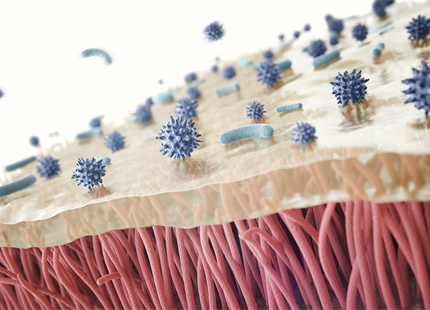
Contact us today to learn more about humidity for Germ Reduction...

Why Humidify... For Germ Reduction
Illnesses are transferred by various pathogenic microorganisms — especially viruses, bacteria and fungus. Bacteria can self-reproduce. Viruses, such as the constantly changing influenza virus which triggers the real flu, require a host for reproduction. In the process, they destroy the latter’s cells. The body’s own defense cells of the immune system have to eradicate cells which have been attacked by viruses. Bacteria such as salmonella or legionella can for example trigger illnesses through their metabolic products. The washing of hands and regular ventilation reduce the transference possibilities through microorganisms. In order to protect others, coughing should be done hygienically into the crook of the arm.
In our climate, most germs are transferred through the air or by direct physical contact (RKI). A balanced relative air humidity significantly reduces the number of germs here. According to Prof. em. Dr.-Ing. habil. U. Marmai (Iselt et al) the “optimum range of relative air humidity is between 40 and 60% at normal ambient air temperatures.”
Many studies (Harper, Noti, Lowen et al) confirm that an increased air humidity significantly reduces the activity of flu viruses. Thus, in an experimental investigation (Noti), US scientists from the National Institute for Occupational Safety and Health (NIOSH) showed that even a relative air humidity over 40% significantly reduces the contagion potential of the viruses. Under realistic conditions, researchers investigated the transmission path across the indoor air during the winter months and the contagion potential of the viruses at various relative air humidities. At a low air humidity up to 23 percent, about three quarters were contagious for longer than one hour, while at approx. 43 percent air humidity the level was less than one quarter with a decreasing tendency.
Produce relies on the ability to retain moisture, and a properly humidified environment is highly beneficial in that regard. When a space containing produce is introduced to consistent relative humidity (RH) levels, it allows for consistent moisture absorption. This helps fruit, vegetables and other foods to retain a suitable amount of water weight, which keeps it fresh and in good condition.
Under realistic conditions, researchers investigated the transmission path across the indoor air during the winter months and the contagion potential of the viruses at various relative air humidities. At a low air humidity up to 23 percent, about three quarters were contagious for longer than one hour, while at approx. 43 percent air humidity the level was less than one quarter with a decreasing tendency.
Sources:
Lowen, Mubareka, Steel, Palese: “Influenza virus transmission is dependent on relative humidity and temperature”, 2007
Iselt, Arndt, Wilcke: “Grundlagen der Luftbefeuchtung” [Foundations of air humidification], VDE Verlag, 2005
Green: Field study “Einfluss der relativen Luftfeuchte auf die Erkrankungshäufigkeit von Schülern” [The influence of relative air humidity on the frequency of illness of school pupils], 1985
Uhlenhaut: “Tenazität von Viren — Stabilität und Erhalt der Infektiosität von Viren” [Tenacity of viruses — Stability and maintenance of virus infectiousness]. In:
Biologische Sicherheit in Deutschland [Biological security in Germany], conference proceedings, 2007
RKI Robert Koch Institute, Bundesamt für Bevölkerungsschutz [Federal Office of Civil Protection]: “Biologische Gefahren I — Handbuch zum Bevölkerungsschutz” [Biohazards I — Manual for protecting the population], 2007


Benefits of humidification for germ reduction include:
- Minimizes the risk of airborne infections.
- Reduces premature drying and formation of scabs from coagulated blood.
- Elevates patient and staff overall comfort in hospitals.
- Decreases the occurrence of respiratory issues in newborns.




Spray booth humidification

Why Humidify... For Data Centers

Why Humidify... For Printing

Immune Systems

Dehumidifiers for military storage

Medical device manufacturing humidification

Why Humidify... For Supermarkets

Why Humidify... For Concert Halls

